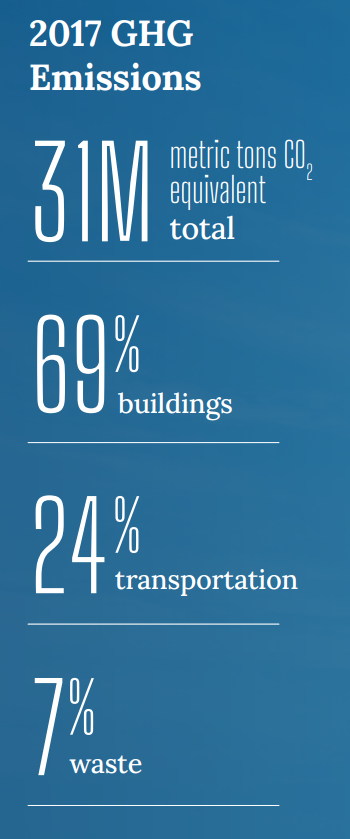Electrify Chicago
An independent tool for viewing City of Chicago building data
According to the
2022 Chicago Climate Action Plan,
69% of Chicago's emissions come from buildings, making
building emissions our biggest challenge and our biggest opportunity as a city
to tackle climate change. At Electrify Chicago, we showcase building performance using
publicly available data supplemented by community-submitted photographs and building
owners.
Start by looking at Chicago's buildings with the highest greenhouse gas intensity i.e. emissions per square foot. Large, efficient, buildings can perform much better than very inefficient small buildings on this metric.
New Article
📰 $30 Million In Missed Fines
The City Of Chicago failed to collect $30 million in potential fines from the building benchmarking ordinance, reducing transparency and accountability.
Legislative update! 🎉
As of late January 2024, legislation is being introduced to require new use more efficient forms of water and space heating, via the Clean And Affordable Buildings Ordinance (CABO), which will reduce the number of highly polluting and inefficient buildings that end up on this site.
If you're in Chicago,
write to your alderman to support the CABO!
Chicago Buildings by Greenhouse Gas Intensity
Note: Data includes large Chicago buildings with data from 2022, unless explicitly stated otherwise.
Note: This data only includes buildings whose emissions are reported
under the
Chicago Energy Benchmarking Ordinance. According to the City “As of 2016,
this list includes all commercial, institutional, and residential buildings larger than
50,000 square feet.” This dataset is also then filtered to only buildings with
reported emissions > 1,000 metric tons CO2 equivalent.
The latest year of data is from 2022, but we update the site regularly when new data is available, and some buildings may have failed to report that year, and only have older data available.
| Property Name / address | Primary Property Type |
Greenhouse Gas Intensity (kg CO2 eq./sqft) |
Total Greenhouse Emissions (metric tons CO2 eq.) |
|---|---|---|---|
|
347 W Chestnut St
347 W Chestnut St
| Multifamily Housing | 5.0 kg/sqft
Lowest 25%
| 2,077 tons
Highest 22%
|
|
Haberdasher Square Lofts
728 W Jackson Blvd
| Multifamily Housing | 5.0 kg/sqft
Lowest 25%
| 2,123 tons
Highest 21%
|
|
Wolf Point West
🕰️
343 W. Wolf Point Plaza
| Multifamily Housing | 5.0 kg/sqft | 2,141 tons |
|
1500 N Clybourn Ave
1500 N Clybourn Ave
| Mixed Use Property | 5.0 kg/sqft
Lowest 25%
| 1,292 tons
Highest 37%
|
|
4900 N Marine Dr
4900 N Marine Dr
| Multifamily Housing | 5.0 kg/sqft
Lowest 25%
| 558 tons
Lowest 31%
|
|
HighSchool_StFrancisdeSalesHS
🕰️
10155 S Ewing Ave
| K-12 School | 5.0 kg/sqft | 463 tons |
|
Parkside - 545
545 W Division
| Multifamily Housing | 5.0 kg/sqft
Lowest 25%
| 698 tons
Lowest 40%
|
|
Stone Scholastic Academy -CPS
(CPS)
6239 N Leavitt St
| K-12 School | 5.0 kg/sqft
Lowest 25%
| 353 tons
Lowest 13%
|
|
Irene C Hernandez -CPS
(CPS)
5440 S St Louis Ave
| K-12 School | 5.0 kg/sqft
Lowest 25%
| 633 tons
Lowest 36%
|
|
Gallistel Language Academy -CPS
(CPS)
10347 S Ewing Ave
| K-12 School | 5.0 kg/sqft
Lowest 25%
| 474 tons
Lowest 24%
|
|
Hendricks C A, Thomas A -CPS
🕰️
(CPS)
4320 S Princeton
| K-12 School | 5.0 kg/sqft | 284 tons |
|
Mayor Robert H Lawrence Apts
(CHA)
655 W 65th St
| Multifamily Housing | 5.0 kg/sqft
Lowest 25%
| 798 tons
Lowest 46%
|
|
Winston Tower #3
7061 N Kedzie Ave
| Multifamily Housing | 5.0 kg/sqft
Lowest 25%
| 1,986 tons
Highest 23%
|
|
212 W Washington Condo
212 W Washington St
| Multifamily Housing | 5.0 kg/sqft
Lowest 25%
| 1,398 tons
Highest 34%
|
|
Vue20 Condo Association
1845 S Michigan Ave
| Multifamily Housing | 5.0 kg/sqft
Lowest 25%
| 1,253 tons
Highest 38%
|
Data Source:
Chicago Energy Benchmarking Data
